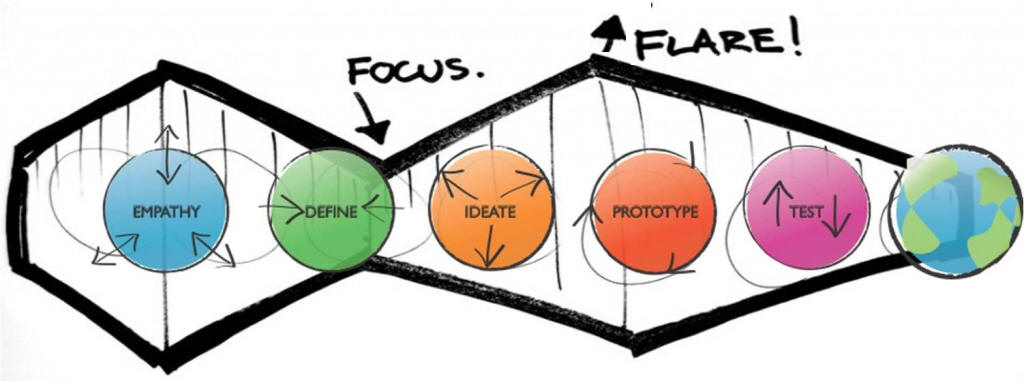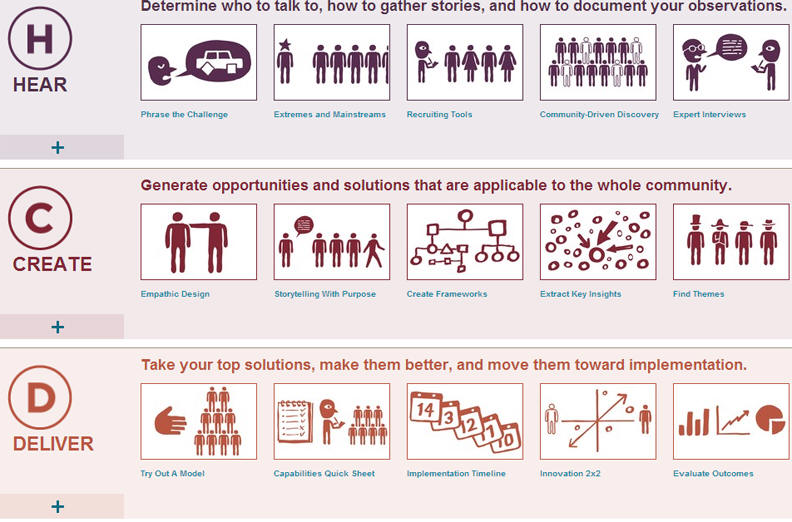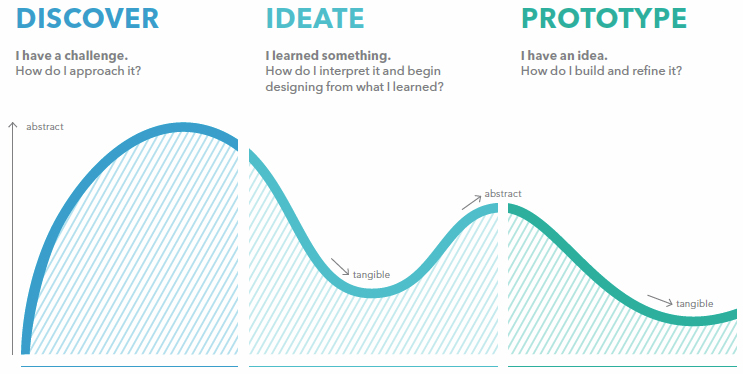|
Empathy and HCD >
4 Online Learning Manuals
Check out these many free manuals to learn the nuts and bolts of
HCD.

An Introduction:
Developing the Design Mind: An Introduction to Design Thinking
==================================================
90 minute Introduction Exercise: Design Project 0:
Overview Page
DP0 (Design Project Zero) is a 90-minute (including debrief)
A 90-minute
video-led cruise through our methodology”
"in 90 minutes you will be taken through a full design
cycle by participating in The Gift-Giving Project."
DP0
Project Topic: Wallet, Gift-Giving, or other - can edit the workbook
The
Wallet Project Example D.School - a
first project Design Project Zero
Video Introduction: Facilitating DP0
(rough cut)
Video: 1 Hour
The Wallet Project is 90-minute (including debrief) fast-paced project though
a full design cycle. Students pair up, show and tell each other about their
wallets, ideate, and make a new solution that is "useful and meaningful" to
their partner.
Wallet Project workbook
The worksheet packet (the paper sheets students work on)
[Print one-sided 11"x17", one per student]
Wallet Project workbook for Facilitators The facilitators guide (a step-by-step guide with talking points to run
the activity)
[Print two-sided 8"x11" or 11"x17", one per facilitator]
Editable Wallet Project

The Gift-Giving Project - Design
Project 0
Manual- Facilitators Guide:
Redesign the Gift-Giving Experience
"The project you’re holding in
your hands is an iteration on the d.school’s iconic “Wallet Project.” The
Wallet Project is an immersive activity meant to give participants a full
cycle through the design thinking process in as short a time as possible. The
project itself gives facilitators the opportunity to touch on the fundamental
values of the d.school—human-centered design, a bias towards action, and a
culture of iteration and rapid prototyping—without attempting to communicate
all of the methods and activities that the term “design thinking”
encompasses."
==================================================
D.School
Web Curriculum
Home page
"We feel that "Bias Toward Action" is a core principle or mindset of design
thinking. In the most basic sense, it means that we promote action-oriented
behavior, rather than discussion based work."
Manual:
An Introduction to Design Thinking: Process Guide
(11
pg pdf)
Good First Overview: d.school:
This eleven-page PDF from the Stanford d.school overview of the process and
the five phases.
Manual:
Bootcamp Bootleg here. (44 pg pdf) - great overview
Good
Second Overview:
d.school: This compilation is intended as an active toolkit to support your design
thinking practice. The guide is not just to read – go out in the world and try
these tools yourself.
Artefact Group
-
Designing for Empathy - A toolkit created by Artefact - step by step
Empathy: Design tool and outcome by Dave McColgin
"Why Empathy? As designers and researchers, we recognize that our work shapes
experiences, behaviors, and systems, whether we do it deliberately or not.
Most of us would like to use this power to create a positive impact. We
believe that product, messaging, and service designs have the potential to
contribute to a more empathetic society that is better able to face the scale
of our shared problems. By applying the lens of empathy to our design process,
we’ve been able to facilitate more innovative solutions This toolkit is
designed to take you from the abstract idea of positive impact through
empathy to a concrete process that can be incorporated into your work."
Manual - Educators Toolkit
click here to
download. v2 (has 4 parts)
VIDEO: "Made for teachers who want to create innovative solutions for
classrooms, schools and communities."
" This toolkit contains the process and
methods of design along with the Designer’s Workbook, adapted specifically for
the context of K-12 education.
It offers new ways to be intentional and
collaborative when designing, and empowers educators to create impactful
solutions."
-
Design Thinking for Educators Toolkit (81 pg pdf)
-
Designers workbook download (48 pg pdf)
-
Designers workbook download blank (48 pg pdf)
-
Quick Start Guide (16 pg pdf)
Manual - An Educator’s Guide to Design Thinking
"INCLUDED IN THIS GUIDE:
- Tips and strategies for bringing design
thinking into the classroom
- Applying design thinking mindsets at your
school
- 7 things you can do tomorrow to incorporate
design thinking
- K-12 Wiki information
from
An Educator’s Guide to Design Thinking pg 16

Manual - Social Enterprise: Human Centered Design ToolKit
(200 pg pdf)
IDEO.ORG: The Human-Centered Design Toolkit was designed specifically for
people, nonprofits, and social enterprises that work with low-income
communities throughout the world. The HCD Toolkit walks users through the
human-centered design process and supports them in activities such as building
observation and empathy skills, prototyping, leading workshops, and
implementing ideas."
"It contains the elements to Human-Centered Design, a process used for decades
to create new solutions for multi-national corporations. "
Manual Online: HCD
process Methods - Work Outline
EMPATHIC
DESIGN
"Your design team will work to develop empathy and connect emotionally with
the people you are designing for, in order to understand the problems and
realities of their lives. Ideally, your team will do research across many
different groups of people and “walk in their shoes’’ before trying this
method"
-
Encourage the team to connect both rationally and emotionally with people
you are designing for. Try out their experience first hand. Feel, see, and
hear as they would while going about this activity and day.
-
Remember your task is to understand and empathize with people, not to judge
them, their behaviors or decisions. Cultural differences are important to
recognize.
-
Make sure the team has spoken with enough people in the HEAR phase to
develop empathy. If not, go back to the field and conduct more research"

OpenIDEO - University Toolkit (PDF 5 pages)
Welcome to OpenIDEO! We’re excited that you’re considering bringing OpenIDEO
design challenges to your campus. This University Toolkit is here to guide you
through the process of sharing OpenIDEO challenges with your campus. Read
through it when you’re getting started, use it as a template when you’re
looking for inspiration or refer to it as a guide when you need to get
unstuck. No matter how you use it, we know you’ll enjoy being a part of such a
collaborative, open and fun design and innovation process – so let’s get
started!
How do you Design - A compendium of
Models (147 pg PDF)
In this book, I have collected over one-hundred descriptionsof design and
development processes, from architecture,
industrial design, mechanical engineering, quality management, and software
development.
HPI School of
Design Thinking Germany - Video
Introduction
lecture
The HPI School of Design Thinking in Potsdam is the first school for
innovation in Europe, which is designed according to the famous d.school at
the Stanford University.
PlusAcumen.org
- Free
Course - Workshop: Human-Centered Design for Social Innovation ***
Human-Centered Design for Social Innovation Course Materials
"Human-Centered Design for Social Innovation is a five-week course that will
introduce you to the concepts of human-centered design and help you use the
design process to create innovative, effective, and sustainable solutions for
social change. No prior design experience necessary.... The course is designed
to be conducted over 5 weeks. However, we understand that some teams might
move at a different pace. " (Join
the Google+ Workshop Community - application request required)
Manuals
1. introduction to human-centered design
2. design challenge part 1: discover
3. design challenge part 2: ideate
4. design challenge part 3: prototype
5. identifying additional challenges )
Week 1 Readings
(pdf pg 7)

|